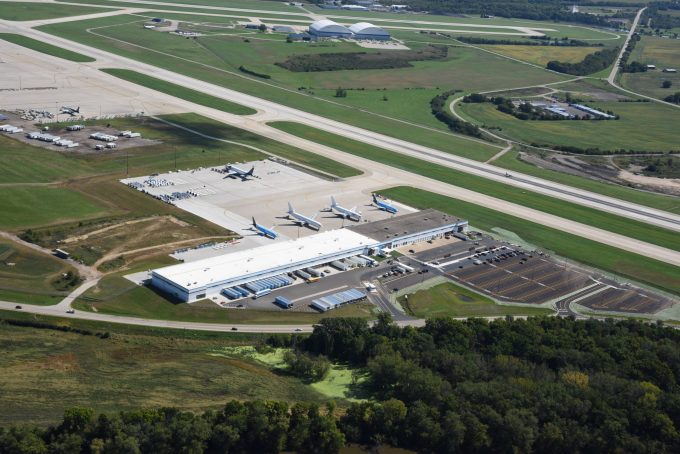US hit by fall in meat exports as China scales back and Brazil steps up
US meat exports are in low gear, affected by bans in the largest market, slowing ...
TFII: SOLID AS USUALMAERSK: WEAKENINGF: FALLING OFF A CLIFFAAPL: 'BOTTLENECK IN MAINLAND CHINA'AAPL: CHINA TRENDSDHL: GROWTH CAPEXR: ANOTHER SOLID DELIVERYMFT: HERE COMES THE FALLDSV: LOOK AT SCHENKER PERFORMANCEUPS: A WAVE OF DOWNGRADES DSV: BARGAIN BINKNX: EARNINGS OUTODFL: RISING AND FALLING AND THEN RISING
TFII: SOLID AS USUALMAERSK: WEAKENINGF: FALLING OFF A CLIFFAAPL: 'BOTTLENECK IN MAINLAND CHINA'AAPL: CHINA TRENDSDHL: GROWTH CAPEXR: ANOTHER SOLID DELIVERYMFT: HERE COMES THE FALLDSV: LOOK AT SCHENKER PERFORMANCEUPS: A WAVE OF DOWNGRADES DSV: BARGAIN BINKNX: EARNINGS OUTODFL: RISING AND FALLING AND THEN RISING

Buoyed by growing international freighter operations, Rockford International Airport (RFD) has completed its third cargo terminal, and it did not take long to find a tenant.
Global handling firm Menzies Aviation has signed a 10-year lease for the new 50,000sq ft building at the airport 65 miles north-west of Chicago.
“The warehouse has state-of-the-art facilities, including pharmaceutical handling capability. With direct airside access, we will provide cargo and freighter handling to chartered and scheduled flights by the middle of this year, and will be hiring a team to run our operations in the coming months,” said Menzies cargo EVP Robert Fordree.
“As well as fitting out the new facility, we’re aiming for most of the ground service equipment to be electric, to support Menzies’ goal of becoming [carbon-] neutral by 2033,” he added.
Peter Weir, the handler’s SVP cargo for the Americas, expects operations to go live by the beginning of July.
“We will put in our IT, cool rooms and get certification like GDP,” he said, adding he is looking to grow business at RFD and attract scheduled freighter operations.
RFD, which bills itself as an efficient alternative to congested Chicago O’Hare, has been a fixture in cargo since UPS established a regional hub there, but its growth has accelerated exponentially during the past three years as a slew of freighter operators started using it while O’Hare was struggling with congestion.
As a result, the airport’s traffic patterns have undergone a significant shift. Most of the international freighter operators serving RFD used to fly across the Atlantic, but recent years saw an influx of transpacific operations, which has created a relatively even balance in geographical reach, explained Zach Oakley, the airport’s deputy director of operations and planning.
Some of this activity, such as passenger freighter flights by Korean Air, has ended and cargo charter activity has diminished in recent months, but the airport authority is confident that the momentum will build again before long.
According to some sources, Amerijet is expected to start flights from Korea to RFD on behalf of Amazon next month.
Mr Oakley said that after the exceptional situation of the past three years, forwarders and their clients had developed a more strategic view of the use of dedicated freighters, which has been a major growth engine for RFD and other second-tier cargo gateways.
“Emphasis on the importance of secondary airports like RFD were highlighted during the pandemic, as nearby passenger hubs reached capacity and carriers looked elsewhere,” said Menzies’ Mr Fordree. “Despite the current, cyclical downturn in volume, we see secondary airports becoming more and more attractive, due to less congestion, lower costs and great surrounding infrastructure that will expedite goods getting from airport to final destination.
“In combination, these benefits will result in significant carbon savings to shippers. We are confident that, in partnership with RFD, we will attract scheduled freighters and specialised cargo to be handled safely, efficiently and with the required certified standards applied.”
Menzies is looking to set up shop at more alternative gateways for cargo, said Mr Weir. It has won a tender to operate a new 150,000sq ft cargo terminal at Philadelphia and it is planning to enter Baltimore Washington Airport.
Philadelphia is attracting firms in the life sciences and pharmaceutical sector, while Baltimore is hosting many charter flights, he pointed out.
“These airports have space to develop. We will see more freighters going into secondary airports,” he said.
Meanwhile Mr Oakley and his colleagues at RFD are looking to develop the airport’s fourth cargo building, as existing capacity has been snapped up. This will be a good deal larger than its latest addition. Potentially it could be as large as 400,000sq ft, he said.
Comment on this article